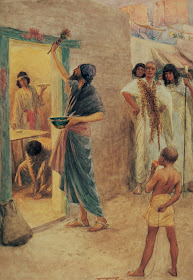Pages
▼
Wednesday, January 27, 2016
Blood, Passover, and Third Nephi
When in bondage to the Egyptians, the Lord commanded the children of Israel to take a male lamb without blemish, sacrifice it, take the blood of the lamb, and put some of it on the door posts of their houses (Exodus 12:5-7). And when the Lord passed through the land to destroy the firstborn he promised:
“I will execute judgment . . . And the blood shall be for a token upon the houses where ye are: and when I see the blood, I will pass over you, and the plague shall not be upon you to destroy you when I smite the land of Egypt” (Exodus 12:12-13).
Israel was commanded to commemorate this feast annually, during the Jewish month (around March or April).
“And this day shall be unto you for a memorial; and ye shall keep it a feast to the Lord throughout your generations” (Exodus 12:14).
Latter-day Saints and other Christians believe that the Israelite Passover pointed to the redemption of Jesus Christ whose blood was shed to provide an atonement for our sins (See for example Donald W. Parry and Jay A. Parry, Symbols and Shadows, 2009, 64-67).
The Book of Mormon records that the Nephites experienced great destruction among their people at time of Jesus’ death. These events commenced at the beginning of the thirty and fourth year on the fourth day of the first month of the new year (3 Nephi 8:5). While we do not know the details of the Nephite calendar, which may have differed in many respects from that in Judea, I assume that the Nephites, when they kept the law of Moses, would have celebrated some form of Passover at approximately the same time as the Israelites of the Old World. Under this assumption several elements of the events described in Mormon’s account in Third Nephi are worth noting.
First, the three days of darkness among the Nephites (3 Nephi 8:19-23; 10:9) obviously recalls the three days of darkness over Egypt when the children of Israel were delivered from bondage (Exodus 10:21-22). This event would have clearly reminded the people of Lehi of the darkness of Egypt. Unlike ancient Israel, however, the Nephites did not have light in their dwellings (Exodus 10:23). The darkness seems to have enveloped everyone. The universal nature of the darkness, whatever its physical cause, would have suggested that the Nephites that by breaking their covenant obligations as a people they had become like the Egyptians and so the Lord was treating them as such.
Second, following three hours of terror and destruction, Jesus announced from heaven the destruction of numerous cities which he had caused to be destroyed (3 Nephi 9:9-22). The inhabitants of those cities rejected the gospel messengers which had been sent to them from God. Rather than repenting of their sins in order to be saved by the blood of the Lamb of God, they persisted in their iniquities and abominations and ironically shed the “blood of the prophets and the saints” (3 Nephi 9:5, 7, 9, 11). Those who were “saved” from the subsequent destruction were considered “more righteous” than the others because they had “received the prophets and stoned them not; and it was they who had not shed the blood of the saints, who were spared” (3 Nephi 9:13; 10:12).
The events described may be interpreted as an ironic reversal of the Passover blessing of protection and deliverance. Having rejected the atoning blood of Christ, the wicked killed the prophets and the saints whose righteous blood stood as a sign against those in these doomed cities, which Jesus could no longer pass by in judgment. The dramatic events, announced to all by Jesus Christ, the “light and the life of the world” (3 Nephi 9:18) from heaven would strikingly emphasize to the people of Lehi the need to repent and return to Jesus and partake of the covenant blessings of protection and salvation.

No comments:
Post a Comment
Note: Only a member of this blog may post a comment.